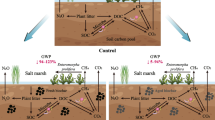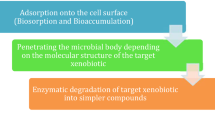Abstract
The potential of using nitrate as a terminal electron acceptor to stimulate anaerobic degradation of mixtures of monochlorophenols (MCPs) or dichlorophenols (DCPs) was evaluated. Contaminated and non-contaminated soils were added to water saturated anaerobic microcosms supplemented with 1 mM or 5 mM nitrate. Denitrification and dechlorination activity were present in three diverse soil types and were maintained upon refeeding both nitrate and the appropriate chlorophenol. However, dechlorination activity could only be serially transferred in enrichments with an added electron donor such as acetate. Dehalogenation activity in enrichments from four of the primary microcosms showed at least five different dechlorination reactions, each mediated by different microbial communities. Three of these are distinct ortho-dechlorinating paths; two are meta-dechlorinating and one is the para-dechlorination of 3,4-DCP. Simultaneous dechlorination and denitrification was observed and both activities could be maintained in microcosms but only in the presence of low nitrate concentrations. Dechlorination and denitrification were mediated by two separate microbial communities; one that dechlorinates without use of nitrate and one that denitrifies while oxidizing the dechlorinated aromatic ring. There was no evidence that dechlorination is mediated by the denitrifying community, however the maintenance of a denitrification potential using low (< 1 mM) nitrate concentrations may be useful for completing the food chain by stimulating the mineralization of phenol and benzoate.
Similar content being viewed by others
References
Berger RS (1972) 2,6-Dichlorophenol, sex pheromone of the lone star tick. Science 177: 704–705.
Boyd SA, Shelton DA, Berry D & Tiedje JM (1983) Anaerobic biodegradation of phenolic compounds in digested sludge. Appl. Environ. Microbiol. 46: 50–54.
Boyd SA & Shelton DR (1984) Anaerobic biodegradation of chlorophenols in fresh and acclimated sludge. Appl. Environ. Microbiol. 47: 272–277.
Christiansen N & Ahring BK (1996) Desulfitobacterium hafniense sp. nov., an anaerobic, reductively dechlorinating bacterium. Int. J. Syst. Bacteriol. 46: 442–44.
Cole JA, Cascarelli A, Mohn WW & Tiedje JM (1994) Isolation and characterization of a novel bacterium growing via reductive dechlorination of 2-chlorophenol. Appl. Environ. Microbiol. 60: 3536–3542.
Cole JA, Sanford RA & Tiedje JM, unpublished data.
Cozza CL & Woods SL (1992) Reductive dechlorination pathways for substituted benzenes: a correlation with electronic properties. Biodegradation 2: 265–278.
deJong E, Field JA, Spinnler H-E, Wijnberg JBPA and deBont JAM (1994) Significant biogenesis of chlorinated aromatics by fungi in natural environments. Appl. Environ. Microbiol. 60: 264–270.
Dietrich G & Winter J (1990) Anaerobic degradation of chlorophenol by an enrichment culture. Applied Microbiology and Biotechnology 34: 253–8.
Dolfing J (1990) Reductive dechlorination of 3- chlorobenzoate is coupled to ATP production and growth in an anaerobic bacterium, strain DCB-1. Arch. Microbiol. 153: 264–266.
Dolfing J & Harrison BK (1992) Gibbs free energy of formation of halogenated aromatic compounds and their potential role as electron acceptors in anaerobic environments. Environ. Sci. Technol. 26: 2213–2218.
Genthner BRS, PriceII WA & Pritchard PH (1989) Anaerobic degradation of chloroaromatic compounds in aquatic sediments under a variety of enrichment conditions. Appl. Environ. Microbiol. 55: 1466–1471.
Genthner BRS, PriceII WA & Pritchard PH (1989b) Characterization of anaerobic dechlorinating consortia derived from aquatic sediments. Appl. Environ. Microbiol. 55: 1472–1476.
Gerritse J, Renard V, Pedro Gomes TM, Lawson PA, Collins MD & Gottschal JC (1996) Desulfitobacterium sp. strain PCE1, an anaerobic bacterium that can grow by reductive dechlorination of tetrachloroethene or ortho-chlorinated phenols. Arch. Microbiol. 165: 132–140.
Gibson SA & Suflita JM (1986) Extrapolation of biodegradation results to groundwater aquifers: reductive dehalogenation of aromatic compounds. Appl. Environ. Microbiol. 52: 681–688.
Gribble GW (1992) Naturally occurring organohalogen compounds —a survey. J. Nat. Prod. 55: 1353–1395.
Häggblom MM (1992) Microbial breakdown of halogenated aromatic pesticides and related compounds. FEMS Microbiol. Rev. 103: 29–72.
Häggblom MM, Rivera MD & Young LY (1993) Influence of alternative electron acceptors on the anaerobic biodegradability of chlorinated phenols and benzoic acids. Appl. Environ. Microbiol. 59: 1162–1167.
Hale DD, Rogers JE & Wiegel J (1991) Environmental factors correlated to dichlorophenol dechlorination in anoxic freshwater sediments. Environ. Toxicol. Chem. 10: 1255–1265.
Hale DH, Rogers JE & Wiegel J (1990) Reductive dechlorination of dichlorophenols by nonadapted and adapted microbial communities in pond sediments. Microbial Ecol. 20: 185–96.
Hendriksen HV, Larsen S & Ahring BK (1992) Influence of a supplemental carbon source on anaerobic dechlorination of pentachlorophenol in granular sludge. Appl. Environ. Microbiol. 58: 365–370.
Hrudey SE, Knettig E, Daignault SA & Fedorak PM (1987) Anaerobic biodegradation of monochlorophenols. Environ. Technol. Lett. 8: 65–76.
Kohring G-W, Rogers JE & Wiegel J (1989) Anaerobic biodegradation of 2,4-dichlorophenol in freshwater lake sediments at different temperatures. Appl. Environ. Microbiol. 55: 348–353.
Kohring G-W, Zhang X & Wiegel J (1989) Anaerobic dechlorination of 2,4-dichlorophenol in freshwater sediments in the presence of sulfate. Appl. Environ. Microbiol. 55: 2735–2737.
Madsen T & Aamand J (1992) Anaerobic transformation and toxicity of trichlorophenols in a stable enrichment culture. Appl. Environ. Microbiol. 58: 557–561.
Madsen T & Licht D (1992) Isolation and characterization of an anaerobic chlorophenol-transforming bacterium. Appl. Environ. Microbiol. 58: 2874–2878.
Mikesell MD & Boyd SA (1985) Reductive dechlorination of the pesticides 2,4-D, 2,4,5-T and pentachlorophenol in anaerobic sludges. J. Environ. Qual. 14: 337–340.
Mohn WW & Tiedje JM (1990) Strain DCB-1 conserves energy for growth from reductive dechlorination coupled to formate oxidation. Arch. Microbiol. 153: 267–272.
Mohn WW & Tiedje JM (1992) Microbial reductive dehalogenation. Microbiol. Rev. 56: 482–507.
Parker WJ, Farquhar GJ & Hall ER (1993) Removal of chlorophenolics and toxicity during high-rate anaerobic treatment of segregated Kraft mill bleach plant effluents. Environ. Sci. Technol. 27: 1783–1789.
Reineke W & Knackmuss HJ (1988) Microbial degradation of haloaromatics. Annu. Rev. Microbiol. 42: 263–287.
Sanford RA (1996). Characterization of microbial populations in anaerobic food webs that reductively dechlorinate chlorophenols. Ph.D. Thesis, Michigan State University, East Lansing, 171 p..
Sanford RA, Cole JR, Löffler FE, & Tiedje JM (1996) Characterization of Desulfitobacterium halorespiricans sp. nov. strain Co23, which grows by coupling the oxidation of lactate to the reductive dechlorination of 3-chloro-4-hydroxybenzoate (3Cl-4-HBA). Appl. Environ. Microbiol. 62: 3800–3808.
Siuda JF & Debernardis JF (1973) Naturally occurring halogenated organic compounds. Lloydia 36: 107–143.
Stevens TO, Watts HD, Walker JJ & Fredrickson JK (1992) Medium formulation presented in a Poster Entitled: Optimization of solid growth medium for isolation and culture of microorganisms from the terrestrial subsurface. In: Abstr. 92nd Gen. Meet. Am. Soc. Microbiol. 1992, (pp 366). American Society for Microbiology, Washington, D.C.
Suflita JM, Horowitz A, Shelton DR & Tiedje JM (1982) Dehalogenation: a novel pathway for the anaerobic biodegradation of haloaromatic compounds. Science 218: 1115–1117.
Thauer RK, Jungermann K & Decker K (1977) Energy conservation in chemotrophic anaerobes. Bacteriol. Rev. 41: 100–180.
Utkin I, Woese C & Wiegel J (1994) Isolation and characterization of Desulfitobacterium dehalogenans gen. nov., sp. nov., an anaerobic bacterium which reductively dechlorinates chlorophenolic compounds. Int. J. Syst. Bacteriol. 44: 612–619.
Wolin EA, Wolin MJ & Wolfe RS (1963) Formation of methane by bacterial extracts. J. Biol. Chem. 238: 2882–2886.
Woods SL, Ferguson JF & Benjamin MM (1989) Characterization of chlorophenol and chloromethoxybenzene biodegradation during anaerobic treatment. Environ. Sci. Technol. 23: 62–68.
Zhang X & Wiegel J (1990) Sequential anaerobic degradation of 2,4-dichlorophenol in freshwater sediments. Appl. Environ. Microbiol. 56: 1119–1127.
Author information
Authors and Affiliations
Rights and permissions
About this article
Cite this article
Sanford, R.A., Tiedje, J.M. Chlorophenol dechlorination and subsequent degradation in denitrifying microcosms fed low concentrations of nitrate. Biodegradation 7, 425–434 (1996). https://doi.org/10.1007/BF00056426
Accepted:
Issue Date:
DOI: https://doi.org/10.1007/BF00056426




